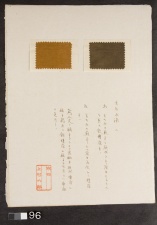Difference between revisions of "Matami - right (96 R)"
Jump to navigation
Jump to search
(username removed) |
(username removed) |
||
| Line 5: | Line 5: | ||
| 96 | | 96 | ||
|- | |- | ||
| − | ! scope="row"| | + | ! scope="row"|Uemura number / title |
| − | | | + | | ; "Haze-some 25" |
|- | |- | ||
! scope="row"|Folder location | ! scope="row"|Folder location | ||
| Line 41: | Line 41: | ||
| ash water | | ash water | ||
|- | |- | ||
| − | ! scope="row"| | + | ! scope="row"|Uemura's notes |
| − | | The color tone of the brown found on the Tobi- | + | | The color tone of the brown found on the Tobi-hachijy textile () is between those achieved by mordanting with ash water and by mordanting with iron. |
|- | |- | ||
| − | ! scope="row"| | + | ! scope="row"|Uemura's date |
| Kyoto | | Kyoto | ||
|} | |} | ||
| − | [[Category: | + | [[Category:Uemura dye archive]] |
Latest revision as of 07:17, 24 July 2013
| Museum number | 96 |
|---|---|
| Uemura number / title | ; "Haze-some 25" |
| Folder location | 2nd shelf |
| Sample location | right (96 R) |
| Fiber type | silk |
| Color | dark brown |
| Dyestuff (Japanese common name) | またみ : Matami |
| Dyestuff (botanical name) | Array |
| Plant part | unspecified |
| Dyestuff extraction | boiled in water |
| Auxiliary agent in dye bath | - |
| Mordant | iron |
| Other auxiliary agent | ash water |
| Uemura's notes | The color tone of the brown found on the Tobi-hachijy textile () is between those achieved by mordanting with ash water and by mordanting with iron. |
| Uemura's date | Kyoto |
